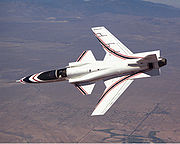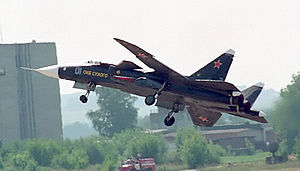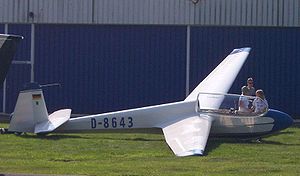
Forward-swept wing
Encyclopedia
A forward-swept wing is an aircraft wing configuration in which the quarter-chord line of the wing
has a forward sweep. The configuration was first proposed in 1936
by German aircraft designers.
Perceived benefits of a forward-swept wing design include
Possible drawbacks of a forward-swept wing include

 Not until World War II
Not until World War II
did designs incorporating forward-swept wings appear (excluding unrealized projects, e.g. Polish Z-17 / Z-18 / Z-47 "Sęp" series); such as the experimental Junkers Ju 287
bomber. After the war, the Soviet Union used Ju 287 as a base for OKB-1 EF 140
prototype
. In 1948, the Soviet Union created the Tsybin's LL-3. The prototype subsequently had a great impact on the Sukhoi's SYB-A, which was completed in 1982.
NACA
, the precursor to the United States
' NASA
, researched the advantages of forward-swept wings on the Bell X-1
, but encountered structural problems with twisting wingtips. Stronger materials were needed, and the aerodynamic benefits seemed minimal or nonexistent.
The concept continued to be dismissed as highly impractical until the late 1970s, when DARPA began investigating the use of newer composite material
s to avoid the problem of reduced divergence speed through aeroelastic tailoring. Fly-by-wire technology allowed for the design to be dynamically unstable
and improved maneuverability. Grumman built two X-29
technology demonstrators, first flying in 1984
, with forward swept wings and canard
s. Maneuverable at high angles of attack, the X-29 remained controllable at 67° angle of attack. Advances in thrust vectoring
technology and a shift in air combat tactics toward medium range missile engagements decreased the relevance of a highly agile fighter aircraft.
In 1997
, Sukhoi
introduced the Su-47
fighter prototype at the Paris Air Show
. It has not yet entered production, although it underwent a series of flight tests and performed at several air show
s.
 The following civilian aircraft feature wings exhibiting a forward sweep:
The following civilian aircraft feature wings exhibiting a forward sweep:
Many high-wing training gliders
with two seats in tandem
have slightly forward-swept wings in order to enable the wing root to be located further aft to prevent the wing from obscuring the rear occupant's lateral visibility. Typical examples are the Schleicher ASK 13
and the Let Kunovice
LET L-13 Blaník.
Wing
A wing is an appendage with a surface that produces lift for flight or propulsion through the atmosphere, or through another gaseous or liquid fluid...
has a forward sweep. The configuration was first proposed in 1936
1936 in aviation
This is a list of aviation-related events from 1936:- Events :* The Royal Air Forces first monoplane bomber, the Avro Anson, enters service.*The German Luftwaffe begins experiments with helle Nachtjagd techniques, the operation of night fighters with the aid of searchlights.*The Soviet aviator...
by German aircraft designers.
Perceived benefits of a forward-swept wing design include
- Mounting the wings further back on the fuselage, allowing for an unobstructed cabin or bomb bay, as the root of the wingboxWingboxThe wing box of an airplane is the structural component from which the wings extend. It is usually limited to the section of the fuselage between the wing roots, although on some aircraft designs, like the Boeing 787, it may be considered to extend further....
will be located further aft, and - Increased maneuverability, due to airflow from wing tip to wing root preventing a stallStall (flight)In fluid dynamics, a stall is a reduction in the lift coefficient generated by a foil as angle of attack increases. This occurs when the critical angle of attack of the foil is exceeded...
of the wing tips and ailerons at high angle of attackAngle of attackAngle of attack is a term used in fluid dynamics to describe the angle between a reference line on a lifting body and the vector representing the relative motion between the lifting body and the fluid through which it is moving...
. Instead, stall will rather occur in the region of the wing root on a forward-swept wing. - This reversed spanwise airflow should reduce wingtip vortices, generating less drag and allowing a smaller wing.
Possible drawbacks of a forward-swept wing include
- When using a conventional metal construction: A reduced divergence speed or, in order to avoid this, an increased wing weight, as wing stiffness needs to be increased.
- A forward-swept wing becomes unstable when the wing root stalls before the tips, causing a pitch-up moment, exacerbating the stall. This effect is more significant with a large forward-sweep.
Military use


World War II
World War II, or the Second World War , was a global conflict lasting from 1939 to 1945, involving most of the world's nations—including all of the great powers—eventually forming two opposing military alliances: the Allies and the Axis...
did designs incorporating forward-swept wings appear (excluding unrealized projects, e.g. Polish Z-17 / Z-18 / Z-47 "Sęp" series); such as the experimental Junkers Ju 287
Junkers Ju 287
-Bibliography:* Hitchcock, Thomas H. Junkers 287 . Acton, MA: Monogram Aviation Publications, 1974. ISBN 0-914144-01-4.-External links:*...
bomber. After the war, the Soviet Union used Ju 287 as a base for OKB-1 EF 140
OKB-1 EF 140
|-See also:-References:* Gordon, Yefim. “Early Soviet Jet Bombers”. Hinkley, Midland. 2004. ISBN 1 85780 181 4* Gunston, Bill. “The Osprey Encyclopaedia of Russian Aircraft 1875–1995”. London, Osprey. 1995. ISBN 1 85532 405 9...
prototype
Prototype
A prototype is an early sample or model built to test a concept or process or to act as a thing to be replicated or learned from.The word prototype derives from the Greek πρωτότυπον , "primitive form", neutral of πρωτότυπος , "original, primitive", from πρῶτος , "first" and τύπος ,...
. In 1948, the Soviet Union created the Tsybin's LL-3. The prototype subsequently had a great impact on the Sukhoi's SYB-A, which was completed in 1982.
NACA
NACA
- Organizations :* National Advisory Committee for Aeronautics, the forerunner of the U.S. federal agency NASA* National Association for Campus Activities, an organization for programmers of university and college activities...
, the precursor to the United States
United States
The United States of America is a federal constitutional republic comprising fifty states and a federal district...
' NASA
NASA
The National Aeronautics and Space Administration is the agency of the United States government that is responsible for the nation's civilian space program and for aeronautics and aerospace research...
, researched the advantages of forward-swept wings on the Bell X-1
Bell X-1
The Bell X-1, originally designated XS-1, was a joint NACA-U.S. Army/US Air Force supersonic research project built by Bell Aircraft. Conceived in 1944 and designed and built over 1945, it eventually reached nearly 1,000 mph in 1948...
, but encountered structural problems with twisting wingtips. Stronger materials were needed, and the aerodynamic benefits seemed minimal or nonexistent.
The concept continued to be dismissed as highly impractical until the late 1970s, when DARPA began investigating the use of newer composite material
Composite material
Composite materials, often shortened to composites or called composition materials, are engineered or naturally occurring materials made from two or more constituent materials with significantly different physical or chemical properties which remain separate and distinct at the macroscopic or...
s to avoid the problem of reduced divergence speed through aeroelastic tailoring. Fly-by-wire technology allowed for the design to be dynamically unstable
Relaxed stability
In aviation, relaxed stability is the tendency of an aircraft to change its attitude and angle of bank of its own accord. An aircraft with relaxed stability will oscillate in simple harmonic motion around a particular attitude at an increasing amplitude....
and improved maneuverability. Grumman built two X-29
Grumman X-29
|-See also:-References:NotesBibliography* Thruelsen, Richard. The Grumman Story. New York: Praeger Publishers, Inc., 1976. ISBN 0-275-54260-2....
technology demonstrators, first flying in 1984
1984 in aviation
This is a list of aviation-related events from 1984:-February:* February 21 - 14 hours and 2 minutes after taking off from New York, Air France pilot Patrick Fourticq and his companion, race driver Henry Pescarolo, land their Piper Malibu in Paris, setting a world record for a trans-Atlantic flight...
, with forward swept wings and canard
Canard (aeronautics)
In aeronautics, canard is an airframe configuration of fixed-wing aircraft in which the forward surface is smaller than the rearward, the former being known as the "canard", while the latter is the main wing...
s. Maneuverable at high angles of attack, the X-29 remained controllable at 67° angle of attack. Advances in thrust vectoring
Thrust vectoring
Thrust vectoring, also thrust vector control or TVC, is the ability of an aircraft, rocket or other vehicle to manipulate the direction of the thrust from its engine or motor in order to control the attitude or angular velocity of the vehicle....
technology and a shift in air combat tactics toward medium range missile engagements decreased the relevance of a highly agile fighter aircraft.
In 1997
1997 in aviation
This is a list of aviation-related events from 1997:-Events:* British Airways adopts a new livery which consists of a revised logo and around 20 different ethnic tailfins featuring art and designs representing many countries around the world.-January:...
, Sukhoi
Sukhoi
Sukhoi Company is a major Russian aircraft manufacturer, headquartered in Begovoy District, Northern Administrative Okrug, Moscow, famous for its fighters...
introduced the Su-47
Sukhoi Su-47
The Sukhoi Su-47 Berkut , also designated S-32 and S-37 during initial development, was an experimental supersonic jet fighter developed by Sukhoi Aviation Corporation...
fighter prototype at the Paris Air Show
Paris Air Show
The Paris Air Show is the world's oldest and largest air show. Established in 1909, it is currently held every odd year at Le Bourget Airport in north Paris, France...
. It has not yet entered production, although it underwent a series of flight tests and performed at several air show
Air show
An air show is an event at which aviators display their flying skills and the capabilities of their aircraft to spectators in aerobatics. Air shows without aerobatic displays, having only aircraft displayed parked on the ground, are called "static air shows"....
s.
Civilian use

- The CZAWCzech Aircraft WorksCzech Sport Aircraft, s.a. is an aeronautics manufacturer based in the Czech Republic.The company's aircraft include the amphibious Mermaid, the SportCruiser and the streamlined Parrot....
Parrot - The 19641964 in aviationFor the year see 1964This is a list of aviation-related events from 1964:- Events :* Chilean President Jorge Alessandri grants the Chilean Navy the authority to operate all types of aircraft without restriction...
HFB-320HFB-320 Hansa Jet|-See also:-References:*Sloot, Emiel. "Hansa Jet Retirement". Air International, October 1994, Vol 47 No 4. pp. 234–235. ISSN 0306-5634.*Taylor, John W. R.. Jane's All The World's Aircraft 1965–66. London: Sampson Low, Marston & Company, 1965....
business jetBusiness jetBusiness jet, private jet or, colloquially, bizjet is a term describing a jet aircraft, usually of smaller size, designed for transporting groups of up to 19 business people or wealthy individuals...
, of which 50 were built, had a forward-swept wing to allow an unimpeded cabin without a wing spar passing through it. - The Saab SafariSaab Safari-See also:- References :* * * *...
, Bölkow JuniorMalmö MFI-9|-See also:-References:* -External links:*...
& ARV Super2ARV Super2The ARV Super2 is a British two-seat, strut-braced, shoulder wing, light aircraft, designed by Bruce Giddings as an affordable trainer. Around 35 aircraft were produced in the 1980s before the manufacturing companies went into liquidation....
all have shoulder wingShoulder wingA shoulder wing is a monoplane aircraft wing configuration in which the wing is mounted near the top of the fuselage, but not on the top....
s for increased visibility, necessitating forward-swept wings to maintain correct CofGCenter of gravityIn physics, a center of gravity of a material body is a point that may be used for a summary description of gravitational interactions. In a uniform gravitational field, the center of mass serves as the center of gravity...
. - The Scaled Composites BoomerangScaled Composites Boomerang-References:...
, a prototype piston twin design which would allow for safe handling in the event of a single engine failure. - The Cessna NGPCessna NGPThe Cessna Next Generation Propeller Aircraft is a proof-of-concept design for a future family of single engine, fixed-gear, high cantilever wing, light aircraft intended for personal, flight training and commercial use....
, a prototype single-engine aircraft intended to eventually replace the Cessna 172Cessna 172The Cessna 172 Skyhawk is a four-seat, single-engine, high-wing fixed-wing aircraft. First flown in 1955 and still in production, more Cessna 172s have been built than any other aircraft.-Design and development:...
and Cessna 182Cessna 182The Cessna 182 Skylane is an American four-seat, single-engine, light airplane, built by Cessna of Wichita, Kansas. It has the option of adding two child seats, installed in the baggage area....
. - The SZD-9 Bocian and PZL Bielsko SZD-50 Puchacz, multi-purpose two-seat sailplanes designed and built in Poland
Many high-wing training gliders
Glider (sailplane)
A glider or sailplane is a type of glider aircraft used in the sport of gliding. Some gliders, known as motor gliders are used for gliding and soaring as well, but have engines which can, in some cases, be used for take-off or for extending a flight...
with two seats in tandem
Tandem
Tandem is an arrangement where a team of machines, animals or people are lined up one behind another, all facing in the same direction....
have slightly forward-swept wings in order to enable the wing root to be located further aft to prevent the wing from obscuring the rear occupant's lateral visibility. Typical examples are the Schleicher ASK 13
Schleicher ASK 13
|-References:**...
and the Let Kunovice
Let Kunovice
Aircraft Industries, a.s., operating as Let Kunovice, is a Czech civil aircraft manufacturer. Its most successful design has been the L-410 Turbolet, of which more than 1000 units have been built...
LET L-13 Blaník.

